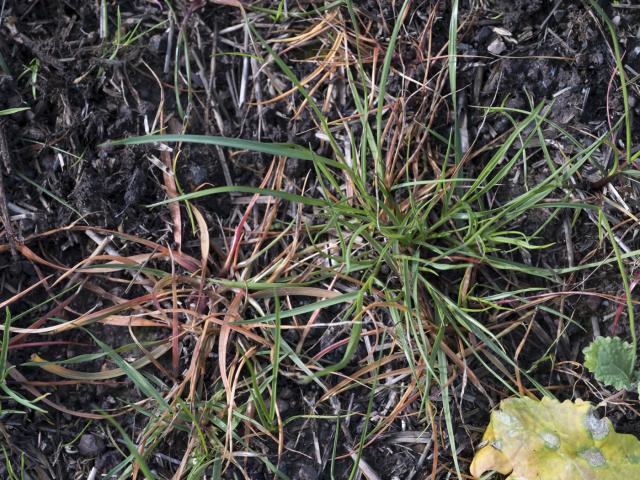Herbicide resistance is the inherited ability of an individual plant to survive the application of a herbicide that would kill a normal population of the same species. This means a herbicide you used to spray no longer works and the weeds continue to grow.
Testing for herbicide susceptibility allows you to determine the herbicide options available to control weeds on your farm.
Not all plants will have the same resistance status across the paddock at the same time. Look for live green plants surviving among dead plants after spraying. These live plants are likely to be resistant.
When the plants in the sprayed area all appear live, this could be herbicide failure rather than resistance.

Image 1: Live annual ryegrass plants among dead plants after spraying with glyphosate. The live plants show resistance to glyphosate. Copyright DPIRD
Rather than testing for herbicide resistance and the herbicides you can no longer use, test for herbicide susceptibility to find the herbicide options you still have.
There are two main types of tests:
- testing seedlings and small plants during the season
- testing seed at the end of the season.
As both methods require samples to be sent to a laboratory for testing (at cost), it is advisable to speak to your agronomist to help decide which herbicides to test for.
Seed tests for herbicide resistance/susceptibility
Collect seeds from weeds suspected of resistance in the paddock prior to harvest. Once the seeds are collected from the paddock, they are sent to the lab where they are grown and sprayed with the specified herbicides to give answers relevant to your farming system. Results are normally available 3 to 4 months after harvest.
Collect seeds or seed heads from suspect areas where plants have survived the herbicide and collect a few seeds from numerous plants. Do not collect seeds/seed heads from a small number of plants as this may bias the sample. If the resistance is widespread, collect from across the paddock or problem area in a W-shaped collection pattern.
About 3000 seeds of each weed (an A4-sized envelope full of good seed heads) are required for a multiple resistance test. This equates to about one cup of annual ryegrass seed and 6 cups of wild radish pods.
Send samples in a paper envelope (not plastic) to either of the following commercial seed testing services:
- Peter Boutsalis, Plant Science Consulting
- John Broster, Graham Centre for Agricultural Innovation, Charles Sturt University
- The Australian Herbicide Resistance Initiative (AHRI) at the University of Western Australia will do herbicide resistance testing.
Quick-Tests for herbicide resistance/susceptibility
A Quick-Test™ requires the collection of whole plants, rather than seeds, from a paddock. This eliminates the problem of seed dormancy and enables a far more rapid turnaround time - it is possible to get results within 4 to 6 weeks.
Quick-Tests are conducted during the growing season rather than over summer. This allows effective management decisions to be made during the same growing season.
Tips for collecting samples
- collect 50 to 100 plants per paddock or suspect area (aim to collect 20 plants per herbicide test)
- carefully pull plants out of the ground and shake soil off from roots
- wrap plants in a couple of sheets of paper towelling (too much paper towel can dry out small plants)
- do not wash plants
- place the wrapped plants in a waterproof plastic bag, like a sealed sandwich bag
- aim to post samples at the beginning of the week so plants are received during the week.
Send Quick-Test samples to Peter Boutsalis at Plant Science Consulting
Note: Quick-Test is only suitable for post emergent herbicides, such as glyphosate, or in-crop selective herbicides. To test for pre-emergent herbicide resistance, particularly trifluralin, you must use the seed test.
More informationRelated content
Contact Us
-
Catherine BorgerGrains Principal Research Scientist
